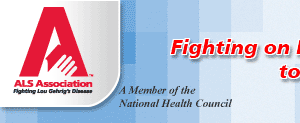

 |
 |
|
May 14, 2007 AAN: Gene Changes, Clinical Findings Highlight Annual Meeting of NeurologistsAt the recent American Academy of Neurology meeting in Boston, researchers presented important advances toward ALS therapeutics. Progress is building toward new gene associations that will provide therapeutic targets. Clinical trial results, also discussed at the meeting, will allow new strategies to streamline future patient trials of an abundant number of candidates in the pipeline. Robert Brown, M.D., D.Phil., of Harvard and Massachusetts General Hospital gave a keynote talk highlighting progress in ALS research, especially in the genetics of the disorder. More than 135 mutations to the SOD1 protein have now been identified in ALS patients, according to a paper his group will publish. His team’s data reported at the meeting reinforce a possible role for the paraoxonase enzymes (PON) that help protect against toxins and may explain suggested environmental risk factors for the disease. Recent experiments reveal that mutant SOD1 is secreted by the nervous system cells, but normal SOD1 remains inside the cells. Mutant SOD1 can act on glia, nervous system support cells. Brown discussed the evidence for glia having a toxic role yet questioned if activated glia are in fact doing a good job presenting evidence for this. Further discussions at the meeting centered on the role of glia. Giving hope to ALS patients, Brown noted that very promising drug trials are planned or underway for therapeutics. A new approach, the gene silencing strategy called antisense, could start clinical testing in 2008. Researchers meanwhile are showing that vaccination with SOD1 may prolong life in animal models of ALS. “Insights are yielding therapeutic progress,” Brown said, “within our careers we will see significant therapies to slow this disease.” Details on New Hints of Gene Associations with ALS Brown’s group presented a poster with data showing an association of the paraoxonase genes with ALS. These genes have variants that appear more often in ALS patients, but the functional change is not yet known. The gene for the protein progranulin can be changed in some cases of frontotemporal dementia and apparently might be a modifier of ALS disease progression. Progranulin is increased in microglia and stimulates production of the helper protein, vascular endothelial growth factor (VEGF). A Belgian study presented by researchers working with Christine Van Broeckhoven, Ph.D., University of Antwerp, Belgium, suggested that progranulin gene variation might play a role in the widely variable nature of ALS disease, and if confirmed, might provide a therapeutic target. Simon Cronin, M.B., working with Orla Hardiman, M.D., at Beaumont Hospital, Dublin, described five variants of the angiogenin gene that occur together in ALS patients (one other gene variant found was for inhibin beta A, a growth factor). David Wu, M.D., Ph.D., working with Guo-fu Hu, Ph.D., at Harvard, found four ALS patients who showed an angiogenin mutation. These mutations produce a decrease in DNA translation when introduced into cells growing in the lab. A link between SOD1 mutations and VEGF was presented by Peter King, M.D., and colleagues at the University of Alabama, Birmingham, who found that placing the mutant SOD1 gene into glia (a glioma U251 cell line) abolished production of VEGF. Pamela Shaw, M.D., University of Sheffield, U.K., and colleagues carried out a gene analysis of a VEGF mutant mouse that develops motor neuron symptoms. Genes showed changes before symptom onset, at onset, and in late stages that are involved in energy metabolism, cholesterol metabolism and translating DNA instructions. Epidemiology findings reported at the meeting give a perspective on the disease and its possible genetic interactions with life exposures. Working from an Irish patient database, Orla Hardiman’s group reported an increased incidence of other neurodegenerative diseases in relatives. The European ALS patient database has not shown an increased incidence of ALS in recent years, as some other studies have suggested. The EURALS data yielded a rate of the disease of about 2.2 cases per hundred thousand people. Glia: Helpers or Harmful in ALS? Stanley Appel, M.D, and colleagues at Methodist Hospital in Houston, showed that a receptor on glia can bind mutant SOD1. An antibody to the receptor (CD14) suppressed the release of inflammation mediators from the glia and could offer a new avenue for therapeutics. Both ALS patients and SOD1 mutant mice have increased mRNA for this receptor. Investigators working with Wim Robberecht, M.D., Ph.D., of Flanders Interuniversity in Leuven, reported an increase early on in the level of the p38 mitogen activated kinase, (MAK) and an inhibitor of this aids survival of motor neurons in culture (the inhibitor is called SB203580). This cell signal amplifier molecule is in both glia and in motor neurons. In a talk following presentation of the Essey award, Christopher Henderson described his team’s findings that also tie in p38 MAK to a process of cell death that involves nitric oxide and is specific to motor neurons. A study of glial cells by Shaw’s group showed that 59 of 61 genes are suppressed by the presence of mutant SOD1. The genes are involved in motility and adhesion. So early on, the glial cells may not do their job when the mutation is there. When glial cells remove apoptotic cells, they are supposed to produce anti-inflammatory signals. Activity tests show they are sluggish. Shaw’s group also compared glia with and without mutant SOD1 growing in the lab. The mutant glia were more reactive yet they have reduced ability to adhere to other cells. John Weiss, M.D., Ph.D., at the University of California, Irvine, proposes a feed forward model to show that the glial cells called astrocytes might participate in some harmful aspects in ALS. As the astrocytes are overwhelmed, reactive molecules accumulate, the glutamate transporter is lost, and the glutamate levels rise near the motor neurons. A selective blocker of a particular, calcium-permeable glutamate receptor localized on astrocytes, given for a month, seems to preserve glutamate uptake and spares motor neurons in SOD1 mutant mice. Clinical Trial Results Sodium phenylbutyrate in a Phase II safety and dose increasing trial appears to be safe and well tolerated. Merit Cudkowicz, M.D., at Massachusetts General Hospital and collaborators reported the findings in 40 patients taking this histone deacetylase (HDAC) inhibitor, which is also being considered in Huntington’s disease. Comparison was with a placebo group from the trial of celecoxib in ALS. Most (80%) of ALS patients enrolled completed the study. A relevant marker, Histone acetylation, was decreased at entry and the drug increased this but not back to normal levels, nor did higher drug doses boost it further. This drug is approved for a rare childhood disease but would need additional toxicity testing in animals in order for the FDA to allow a Phase III trial in ALS. Paul Gordon, M.D., at Columbia University working with Robert Miller, M.D., and colleagues in the Western ALS Study Group, presented a Phase III trial of minocycline that showed an adverse effect in the primary outcome, the ALS functional rating scale (ALSFRS). This was a statistically significant difference with treated patients showing a 24% more rapid decline by this self-reported rating of activities of daily living. Not statistically significant, but accompanying this decline, was a 15% more rapid loss of breathing ability measured by the forced vital capacity (FVC, a breathing measure) and 14 % more accelerated loss of strength by manual muscle testing. No change appeared in survival time or need for tracheotomy or extensive non-invasive aid to breathing. With the treatment there were increased reports of dizziness, diarrhea and headache. Weight loss did not accelerate in treated patients. Minocycline worsens self-rated function in ALS, according to the ALSFRS, but survival and other measures of quality of life were not statistically different, said Gordon, noting that the findings provide a word of caution in prescribing open label medications. Antisense on Track for Clinical Trial The antisense approach to shut off the production of mutant SOD1 protein in familial ALS is in the midst of primate safety testing. No problems have been encountered. The required rat toxicity testing is funded and will start soon. Phase I human safety testing should start in 2008. Timothy Miller, M.D., Ph.D., University of California, San Diego, reported at the meeting that in the SOD1 mutant rat, the antisense treatment decreased the production of mutant protein by 30-40%. This is enough to prolong the survival of these treated animals by 30%, although it does not affect the onset of the disease. Possible Biomarkers A set of findings at the meeting related to the search for biomarkers, indicators that would allow testing of blood or other body fluids to detect early signs of ALS and also streamline clinical testing of candidate therapies. The ability of a molecule called Nogo A to serve as a disease marker in muscle is being investigated by researchers working with Jean Philippe Loeffler, Ph.D., Louis Pasteur University, Strasbourg, France. In a prospective study, 87 percent of 23 ALS patients followed to autopsy showed the marker, as did 100% of ALS-FTD patients, 60% of FTD patients and 12% patients with other neuromuscular disorders. The protein was not detected in the muscle of healthy control subjects. They will look for data on individual patient progression and further in other neurological disorders to see if Nogo A is able to differentiate ALS specifically from other conditions. Japanese researchers reported a correlation between the level of certain immune modulators and clinical scores on the ALS functional rating scale. Their findings suggest a possible biomarker role for certain of these immune system proteins, as reported by Jun-ichi Kira, M.D., Ph.D., and colleagues at Kyushu University in Fukuoka, Japan. Patricia Anders, M.S., P.T., working with Cudkowicz, is developing the prototype muscle strength testing device funded through TREAT ALS (Translational Research Advancing Therapy for ALS) that should provide a way to streamline testing in clinical trials. Other posters on biomarkers showed that remaining deltoid muscle nerve supply correlates to a certain degree with the extent of diaphragm nerve supply (83% sensitivity, 61% specificity) and that the so-called “timed get up and go” test could be a useful and easy outcome measure for ALS clinical trials. The test predicts falls, in contrast to a commonly used rating scale, ALSFRS-R, and manual muscle testing. Terry Heiman-Patterson, M.D., and colleagues at Drexel University in Philadelphia, showed patients with respiratory insufficiency are using fats instead of carbohydrates, as fat metabolism makes less CO2 and puts less work on breathing. ALS patients also use less protein in their metabolic process. The change in metabolism correlates with the ALS functional rating scale. This finding can guide how to address nutrition in ALS. For details on posters and presentations mentioned in this summary, see AAN Meeting 2007: ALS Advances at a Glance. |
|
| |||
The ALS Association �2004 The ALS Association. All rights reserved. Contact the Webmaster |